ESP CHEVROLET KODIAK 2007 User Guide
[x] Cancel search | Manufacturer: CHEVROLET, Model Year: 2007, Model line: KODIAK, Model: CHEVROLET KODIAK 2007Pages: 430, PDF Size: 6.06 MB
Page 220 of 430

Passing
The driver of a vehicle about to pass another on a
two-lane highway waits for just the right moment,
accelerates, moves around the vehicle ahead,
then goes back into the right lane again.
A simple maneuver?
Not necessarily! Passing another vehicle on a
two-lane highway is a potentially dangerous move,
since the passing vehicle occupies the same
lane as oncoming traffic for several seconds.
A miscalculation, an error in judgment, or a brief
surrender to frustration or anger can suddenly
put the passing driver face to face with the worst
of all traffic accidents — the head-on collision.
So here are some tips for passing:
•A vehicle like yours takes a longer time to
reach passing speed, so you will need a
longer stretch of clear road ahead than you
would with a passenger car.
•Drive ahead. Look down the road, to the
sides, and to crossroads for situations
that might affect your passing patterns. If you
have any doubt whatsoever about making
a successful pass, wait for a better time.
•Watch for traffic signs, pavement markings, and
lines. If you can see a sign up ahead that might
indicate a turn or an intersection, delay your
pass. A broken center line usually indicates it is
all right to pass, providing the road ahead is
clear. Never cross a solid line on your side of
the lane or a double solid line, even if the road
seems empty of approaching traffic.
•Do not get too close to the vehicle you want to
pass while you are awaiting an opportunity. For
one thing, following too closely reduces your
area of vision, especially if you are following a
larger vehicle. Also, you will not have adequate
space if the vehicle ahead suddenly slows or
stops. Keep back a reasonable distance.
220
Page 222 of 430
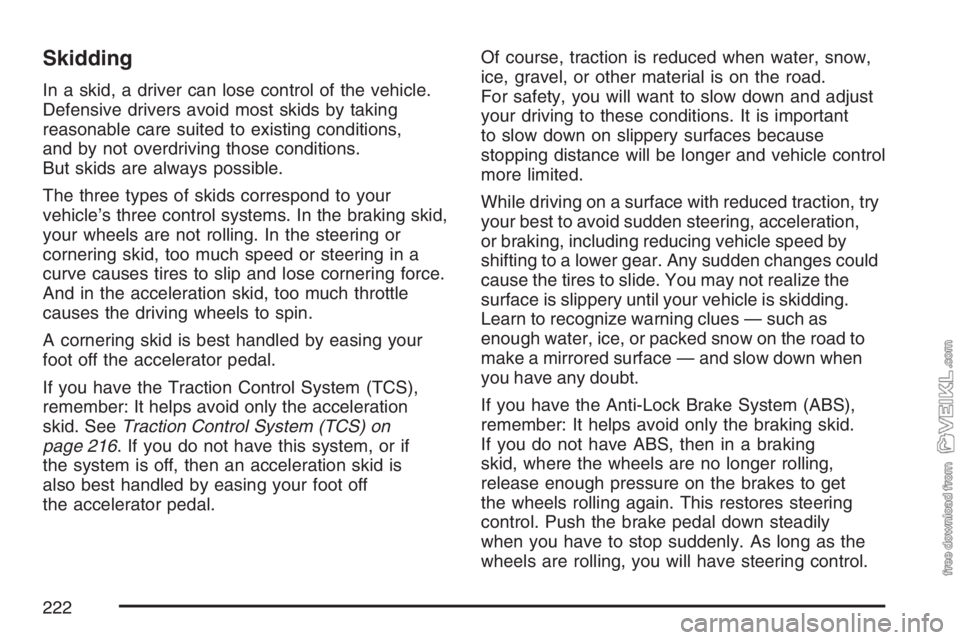
Skidding
In a skid, a driver can lose control of the vehicle.
Defensive drivers avoid most skids by taking
reasonable care suited to existing conditions,
and by not overdriving those conditions.
But skids are always possible.
The three types of skids correspond to your
vehicle’s three control systems. In the braking skid,
your wheels are not rolling. In the steering or
cornering skid, too much speed or steering in a
curve causes tires to slip and lose cornering force.
And in the acceleration skid, too much throttle
causes the driving wheels to spin.
A cornering skid is best handled by easing your
foot off the accelerator pedal.
If you have the Traction Control System (TCS),
remember: It helps avoid only the acceleration
skid. SeeTraction Control System (TCS) on
page 216. If you do not have this system, or if
the system is off, then an acceleration skid is
also best handled by easing your foot off
the accelerator pedal.Of course, traction is reduced when water, snow,
ice, gravel, or other material is on the road.
For safety, you will want to slow down and adjust
your driving to these conditions. It is important
to slow down on slippery surfaces because
stopping distance will be longer and vehicle control
more limited.
While driving on a surface with reduced traction, try
your best to avoid sudden steering, acceleration,
or braking, including reducing vehicle speed by
shifting to a lower gear. Any sudden changes could
cause the tires to slide. You may not realize the
surface is slippery until your vehicle is skidding.
Learn to recognize warning clues — such as
enough water, ice, or packed snow on the road to
make a mirrored surface — and slow down when
you have any doubt.
If you have the Anti-Lock Brake System (ABS),
remember: It helps avoid only the braking skid.
If you do not have ABS, then in a braking
skid, where the wheels are no longer rolling,
release enough pressure on the brakes to get
the wheels rolling again. This restores steering
control. Push the brake pedal down steadily
when you have to stop suddenly. As long as the
wheels are rolling, you will have steering control.
222
Page 223 of 430
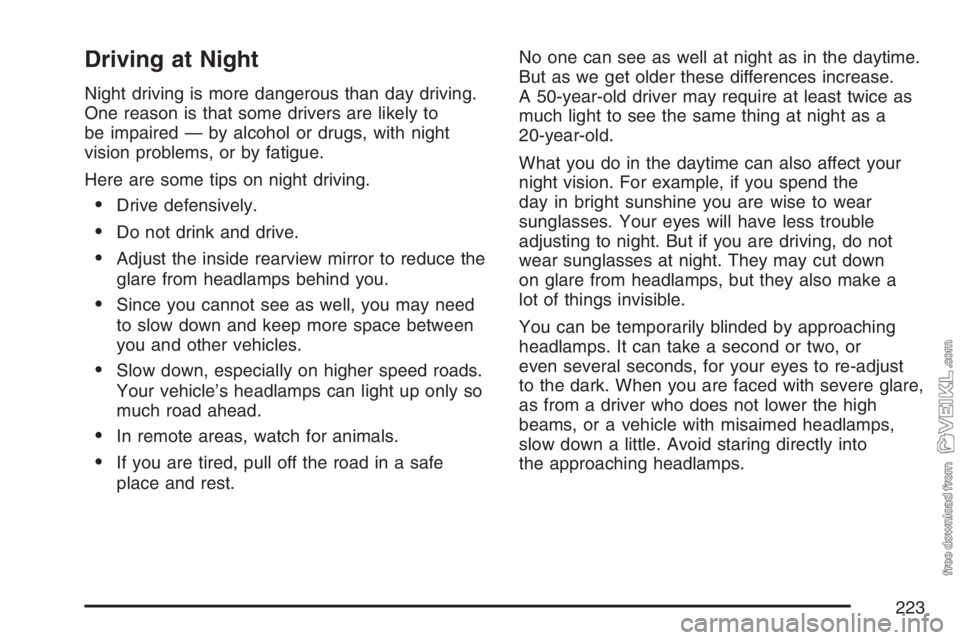
Driving at Night
Night driving is more dangerous than day driving.
One reason is that some drivers are likely to
be impaired — by alcohol or drugs, with night
vision problems, or by fatigue.
Here are some tips on night driving.
•Drive defensively.
•Do not drink and drive.
•Adjust the inside rearview mirror to reduce the
glare from headlamps behind you.
•Since you cannot see as well, you may need
to slow down and keep more space between
you and other vehicles.
•Slow down, especially on higher speed roads.
Your vehicle’s headlamps can light up only so
much road ahead.
•In remote areas, watch for animals.
•If you are tired, pull off the road in a safe
place and rest.No one can see as well at night as in the daytime.
But as we get older these differences increase.
A 50-year-old driver may require at least twice as
much light to see the same thing at night as a
20-year-old.
What you do in the daytime can also affect your
night vision. For example, if you spend the
day in bright sunshine you are wise to wear
sunglasses. Your eyes will have less trouble
adjusting to night. But if you are driving, do not
wear sunglasses at night. They may cut down
on glare from headlamps, but they also make a
lot of things invisible.
You can be temporarily blinded by approaching
headlamps. It can take a second or two, or
even several seconds, for your eyes to re-adjust
to the dark. When you are faced with severe glare,
as from a driver who does not lower the high
beams, or a vehicle with misaimed headlamps,
slow down a little. Avoid staring directly into
the approaching headlamps.
223
Page 226 of 430

Driving Through Deep Standing Water
Notice:If you drive too quickly through deep
puddles or standing water, water can come in
through your engine’s air intake and badly
damage your engine. Never drive through water
that is slightly lower than the underbody of your
vehicle. If you cannot avoid deep puddles or
standing water, drive through them very slowly.
Driving Through Flowing Water
{CAUTION:
Flowing or rushing water creates strong
forces. If you try to drive through �owing
water, as you might at a low water
crossing, your vehicle can be carried away.
As little as six inches of �owing water
can carry away a smaller vehicle. If this
happens, you and other vehicle occupants
could drown. Do not ignore police warning
signs, and otherwise be very cautious
about trying to drive through �owing water.
Some Other Rainy Weather Tips
•Turn on your low-beam headlamps and your
marker and clearance lamps, if your vehicle
has them — not just your parking lamps — to
help make you more visible to others.
•Besides slowing down, allow some extra
following distance. And be especially careful
when you pass another vehicle. Allow yourself
more clear room ahead, and be prepared to
have your view restricted by road spray.
•Have good tires with proper tread depth.
SeeTires on page 321.
226
Page 238 of 430

Loading Your Vehicle
It is the responsibility of the Final Stage
manufacturer to install a Certification label on
your vehicle. This label shows how much weight
your vehicle can properly carry. It may also
show the size of the vehicle’s original tires, and
the inflation pressures needed to obtain the
gross weight capacity of your vehicle. This is
called the Gross Vehicle Weight Rating (GVWR).
The tire information could also be shown on a
separate Tire Information label.
The GVWR includes the weight of the vehicle,
all occupants, fuel, and cargo.
The Certification label also tells you the maximum
weight for the front and rear axles, called the
Gross Axle Weight Rating (GAWR). To find out
the actual loads on your front and rear axles,
go to a weigh station and weigh your vehicle.
Your dealer can help you with this. Be sure
to spread out your load equally on both sides
of the center line.Never exceed the GVWR for your vehicle, or the
GAWR for either the front or rear axle.
And, if you do have a heavy load, spread it out.
{CAUTION:
Do not load your vehicle any heavier than
the Gross Vehicle Weight Rating (GVWR),
or either the maximum front or rear Gross
Axle Weight Rating (GAWR). If you do,
parts on your vehicle can break, and it
can change the way your vehicle handles.
These could cause you to lose control
and crash. Also, overloading can shorten
the life of your vehicle.
238
Page 254 of 430
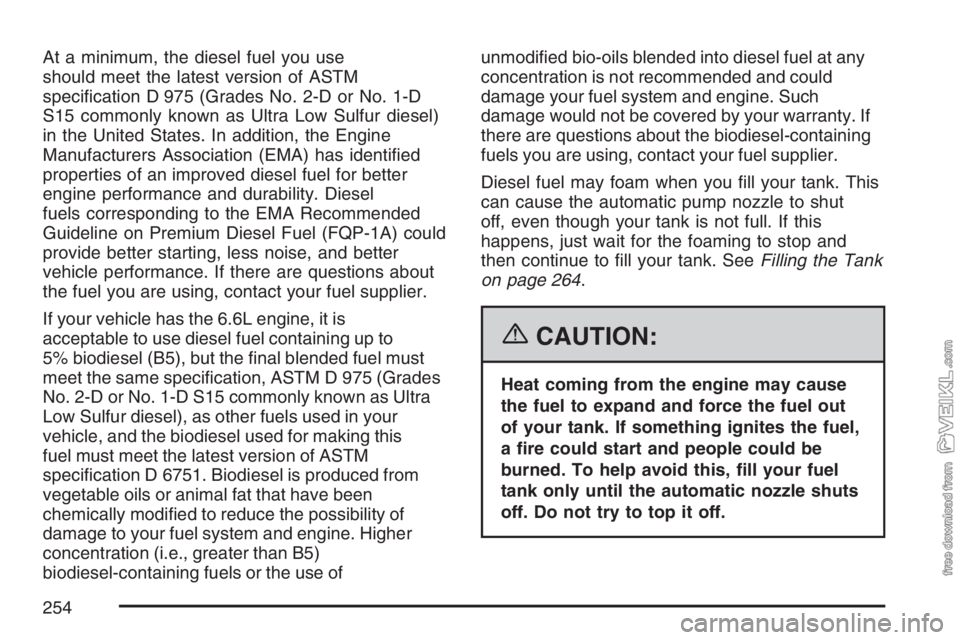
At a minimum, the diesel fuel you use
should meet the latest version of ASTM
specification D 975 (Grades No. 2-D or No. 1-D
S15 commonly known as Ultra Low Sulfur diesel)
in the United States. In addition, the Engine
Manufacturers Association (EMA) has identified
properties of an improved diesel fuel for better
engine performance and durability. Diesel
fuels corresponding to the EMA Recommended
Guideline on Premium Diesel Fuel (FQP-1A) could
provide better starting, less noise, and better
vehicle performance. If there are questions about
the fuel you are using, contact your fuel supplier.
If your vehicle has the 6.6L engine, it is
acceptable to use diesel fuel containing up to
5% biodiesel (B5), but the final blended fuel must
meet the same specification, ASTM D 975 (Grades
No. 2-D or No. 1-D S15 commonly known as Ultra
Low Sulfur diesel), as other fuels used in your
vehicle, and the biodiesel used for making this
fuel must meet the latest version of ASTM
specification D 6751. Biodiesel is produced from
vegetable oils or animal fat that have been
chemically modified to reduce the possibility of
damage to your fuel system and engine. Higher
concentration (i.e., greater than B5)
biodiesel-containing fuels or the use ofunmodified bio-oils blended into diesel fuel at any
concentration is not recommended and could
damage your fuel system and engine. Such
damage would not be covered by your warranty. If
there are questions about the biodiesel-containing
fuels you are using, contact your fuel supplier.
Diesel fuel may foam when you fill your tank. This
can cause the automatic pump nozzle to shut
off, even though your tank is not full. If this
happens, just wait for the foaming to stop and
then continue to fill your tank. SeeFilling the Tank
on page 264.
{CAUTION:
Heat coming from the engine may cause
the fuel to expand and force the fuel out
of your tank. If something ignites the fuel,
a �re could start and people could be
burned. To help avoid this, �ll your fuel
tank only until the automatic nozzle shuts
off. Do not try to top it off.
254
Page 255 of 430
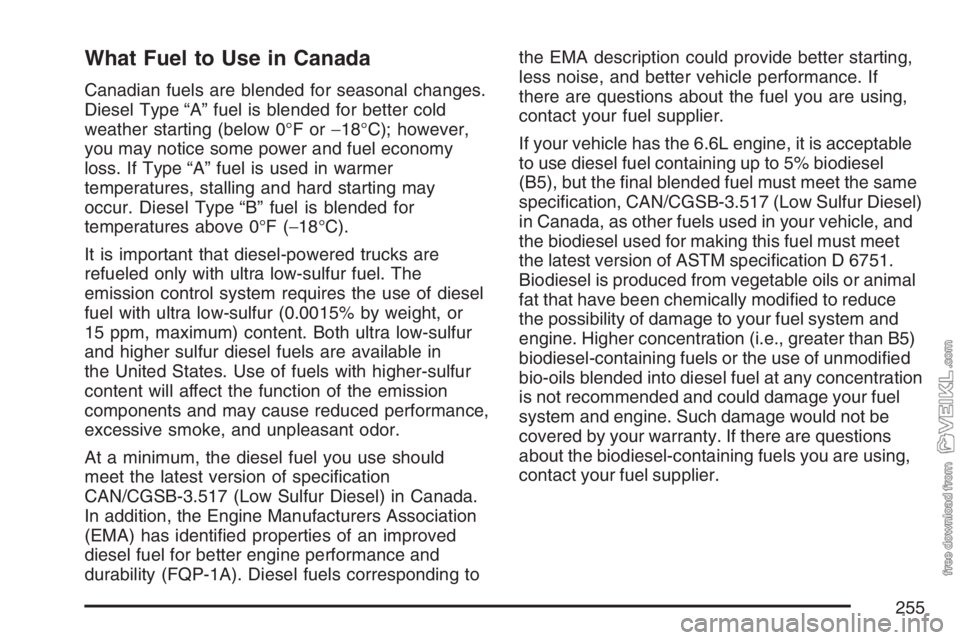
What Fuel to Use in Canada
Canadian fuels are blended for seasonal changes.
Diesel Type “A” fuel is blended for better cold
weather starting (below 0°F or−18°C); however,
you may notice some power and fuel economy
loss. If Type “A” fuel is used in warmer
temperatures, stalling and hard starting may
occur. Diesel Type “B” fuel is blended for
temperatures above 0°F (−18°C).
It is important that diesel-powered trucks are
refueled only with ultra low-sulfur fuel. The
emission control system requires the use of diesel
fuel with ultra low-sulfur (0.0015% by weight, or
15 ppm, maximum) content. Both ultra low-sulfur
and higher sulfur diesel fuels are available in
the United States. Use of fuels with higher-sulfur
content will affect the function of the emission
components and may cause reduced performance,
excessive smoke, and unpleasant odor.
At a minimum, the diesel fuel you use should
meet the latest version of specification
CAN/CGSB-3.517 (Low Sulfur Diesel) in Canada.
In addition, the Engine Manufacturers Association
(EMA) has identified properties of an improved
diesel fuel for better engine performance and
durability (FQP-1A). Diesel fuels corresponding tothe EMA description could provide better starting,
less noise, and better vehicle performance. If
there are questions about the fuel you are using,
contact your fuel supplier.
If your vehicle has the 6.6L engine, it is acceptable
to use diesel fuel containing up to 5% biodiesel
(B5), but the final blended fuel must meet the same
specification, CAN/CGSB-3.517 (Low Sulfur Diesel)
in Canada, as other fuels used in your vehicle, and
the biodiesel used for making this fuel must meet
the latest version of ASTM specification D 6751.
Biodiesel is produced from vegetable oils or animal
fat that have been chemically modified to reduce
the possibility of damage to your fuel system and
engine. Higher concentration (i.e., greater than B5)
biodiesel-containing fuels or the use of unmodified
bio-oils blended into diesel fuel at any concentration
is not recommended and could damage your fuel
system and engine. Such damage would not be
covered by your warranty. If there are questions
about the biodiesel-containing fuels you are using,
contact your fuel supplier.
255
Page 282 of 430
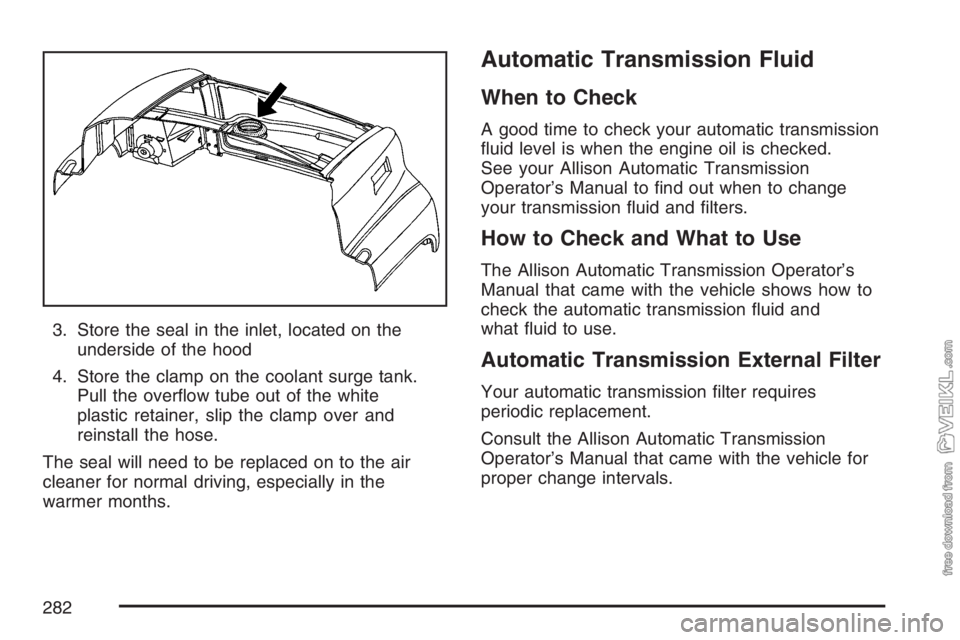
3. Store the seal in the inlet, located on the
underside of the hood
4. Store the clamp on the coolant surge tank.
Pull the overflow tube out of the white
plastic retainer, slip the clamp over and
reinstall the hose.
The seal will need to be replaced on to the air
cleaner for normal driving, especially in the
warmer months.
Automatic Transmission Fluid
When to Check
A good time to check your automatic transmission
fluid level is when the engine oil is checked.
See your Allison Automatic Transmission
Operator’s Manual to find out when to change
your transmission fluid and filters.
How to Check and What to Use
The Allison Automatic Transmission Operator’s
Manual that came with the vehicle shows how to
check the automatic transmission fluid and
what fluid to use.
Automatic Transmission External Filter
Your automatic transmission filter requires
periodic replacement.
Consult the Allison Automatic Transmission
Operator’s Manual that came with the vehicle for
proper change intervals.
282
Page 306 of 430

Notice:Ignoring these steps could result in
costly damage to your vehicle that would
not be covered by your warranty.
Trying to start your vehicle by pushing or
pulling it will not work, and it could damage
your vehicle.
1. Check the other vehicle. It must have a
12-volt battery (or batteries) with a negative
ground system.
Notice:If the other vehicle’s system is not a
12-volt system with a negative ground,
both vehicles can be damaged. Only use
vehicles with 12-volt systems with negative
grounds to jump start your vehicle.
If you have a diesel engine vehicle with
two batteries (or more), you should know
before you begin that, especially in cold
weather, you may not be able to get enough
power from a single battery in another
vehicle to start your diesel engine.
If your vehicle has more than one battery, use
the one closest to the starter — this will
reduce electrical resistance.2. Get the vehicles close enough so the jumper
cables can reach, but be sure the vehicles are
not touching each other. If they are, it could
cause a ground connection you do not
want. You would not be able to start your
vehicle, and the bad grounding could damage
the electrical systems.
To avoid the possibility of the vehicles rolling,
set the parking brake firmly on both vehicles
involved in the jump start procedure. Put
an automatic transmission in PARK (P) or a
manual transmission in NEUTRAL before
setting the parking brake. If you have a
four-wheel-drive vehicle, be sure the transfer
case is in a drive gear, not in NEUTRAL.
Notice:If you leave your radio or other
accessories on during the jump starting
procedure, they could be damaged. The repairs
would not be covered by your warranty.
Always turn off your radio and other
accessories when jump starting your vehicle.
3. Turn off the ignition on both vehicles. Unplug
unnecessary accessories plugged into the
cigarette lighter or accessory power outlets.
306
Page 330 of 430
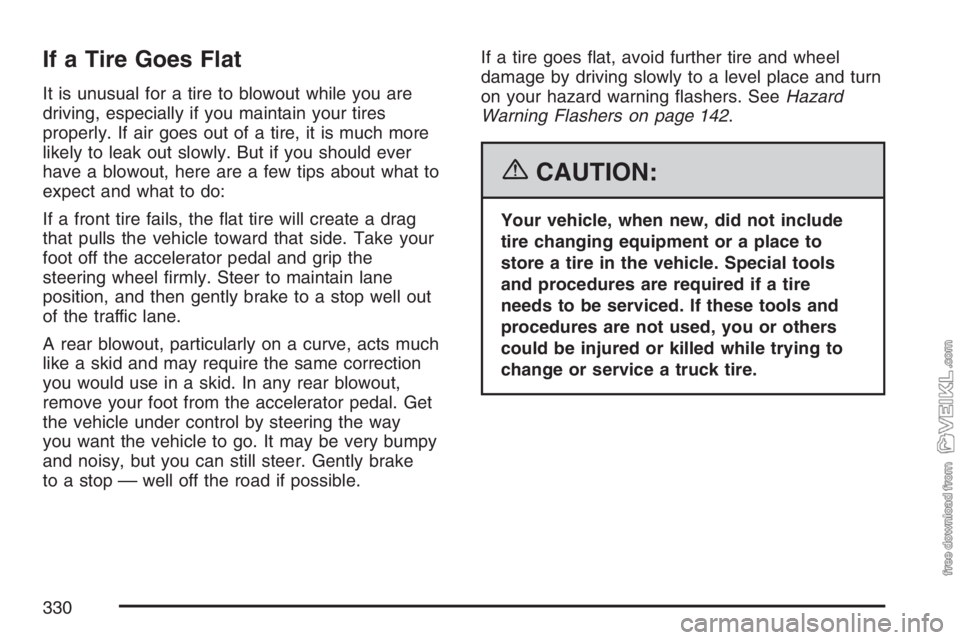
If a Tire Goes Flat
It is unusual for a tire to blowout while you are
driving, especially if you maintain your tires
properly. If air goes out of a tire, it is much more
likely to leak out slowly. But if you should ever
have a blowout, here are a few tips about what to
expect and what to do:
If a front tire fails, the flat tire will create a drag
that pulls the vehicle toward that side. Take your
foot off the accelerator pedal and grip the
steering wheel firmly. Steer to maintain lane
position, and then gently brake to a stop well out
of the traffic lane.
A rear blowout, particularly on a curve, acts much
like a skid and may require the same correction
you would use in a skid. In any rear blowout,
remove your foot from the accelerator pedal. Get
the vehicle under control by steering the way
you want the vehicle to go. It may be very bumpy
and noisy, but you can still steer. Gently brake
to a stop –– well off the road if possible.If a tire goes flat, avoid further tire and wheel
damage by driving slowly to a level place and turn
on your hazard warning flashers. SeeHazard
Warning Flashers on page 142.
{CAUTION:
Your vehicle, when new, did not include
tire changing equipment or a place to
store a tire in the vehicle. Special tools
and procedures are required if a tire
needs to be serviced. If these tools and
procedures are not used, you or others
could be injured or killed while trying to
change or service a truck tire.
330